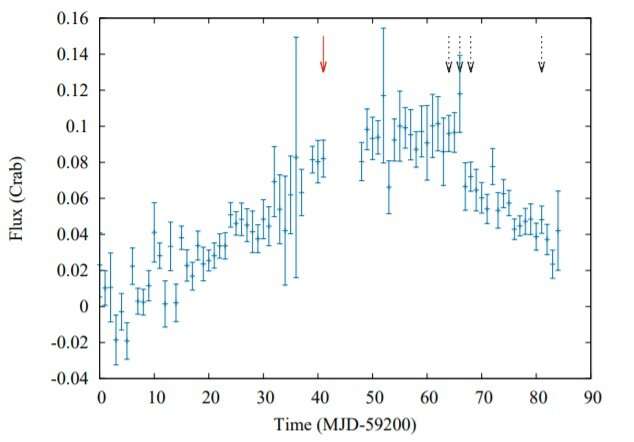March 31, 2021 report
Indian astronomers probe X-ray pulsar 2S 1417–624

Using the Neutron Star Interior Composition Explorer (NICER) instrument aboard the International Space Station (ISS) and NASA's Swift spacecraft, astronomers from India have investigated an X-ray pulsar known as 2S 1417–624. Results of the study, published March 24 on arXiv.org, provide important information about the evolution of different timing and spectral properties of this source during its recent outburst.
X-ray pulsars (also known as accretion-powered pulsars) are sources displaying strict periodic variations in X-ray intensity, consisting of a magnetized neutron star in orbit with a normal stellar companion. In these binary systems, the X-ray emission is powered by the release of gravitational potential energy as material is accreted from a massive companion. X-ray pulsars are among the most luminous objects in the X-ray sky.
2S 1417–624 was detected in 1978 using the Small Astronomy Satellite (SAS-3). Subsequent observations identified X-ray pulsations from this source with a period of 17.64 seconds and found that this binary has an orbital period of approximately 42 days. In January 2021, a giant outburst of 2S 1417–624 started, which was detected by NASA's Fermi and Swift spacecraft, as well as by the Monitor of All-sky X-ray Image (MAXI) on ISS.
After the recent bursting activity of 2S 1417–624 has been identified, Manoj Mandal and Sabyasachi Pal of the Midnapore City College in India, began investigating the evolution of this source.
"We have studied the evolution of different timing and spectral properties of the X-ray pulsar 2S 1417–624 during the recent outburst in January 2021 based on the Neutron Star Interior Composition Explorer and Swift observations," the astronomers wrote in the paper.
According to Mandal and Pal, the pulse profile of 2S 1417–624 shows multiple peaks and dips with an energy-dependent nature. This is consistent with the results from other observations of the source that were carried out during the previous giant outburst in 2009.
The study found that the geometry of the pulse profile evolved significantly with energy, what is consistent with previous observations. When it comes to the pulse fraction, it increases with energy and such a trend was also seen during the giant outburst of the source in 2018.
Furthermore, the new observations show that emission from 2S 1417–624 evolved from soft to hard during the rising phase of the outburst and from hard to soft during the decay phase.
"The spectral state changes from soft to hard at the time of increasing phase of the outburst, during the time MJD 59210–59250 and hardness ratio reaches a maximum near the peak of the outburst. The hardness ratio has started to decrease from MJD 59255 and the state changes from hard to soft," the astronomers explained.
The researchers also estimated that the spin period of the pulsar during the 2021 outburst was approximately 17.36 seconds and that it decreases slowly with time. The results indicate that during the latest outburst the source was found to be spinning-up at a rate of about 0.01 nHz/s.
More information: Timing and Spectral Studies of the X-ray Pulsar 2S 1417–624 During the Outburst in 2021 Using NICER and Swift, arXiv:2103.13444 [astro-ph.HE] arxiv.org/abs/2103.13444
© 2021 Science X Network





















